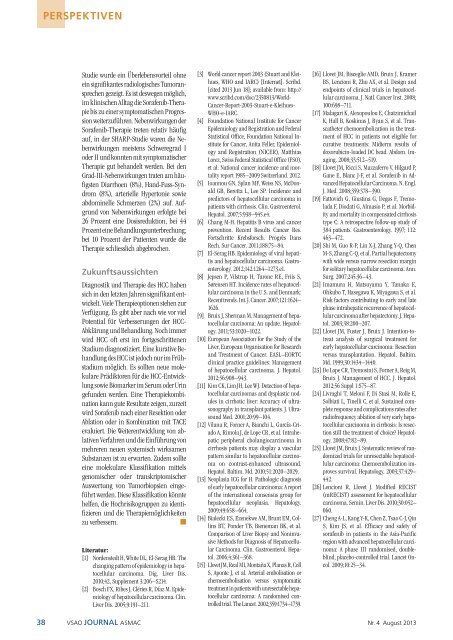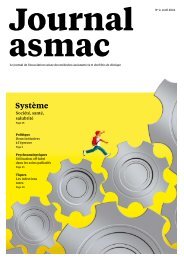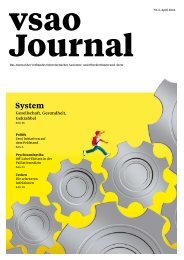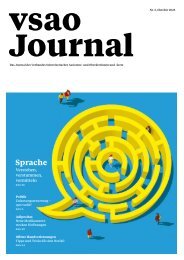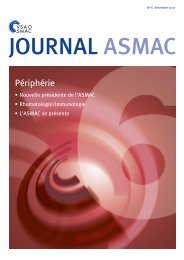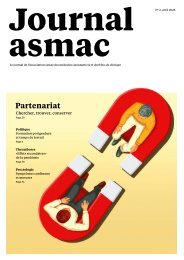VSAO JOURNAL Nr. 4 - August 2013
2. Akt - Zulassungsstopp light / Gastroenterologie/Rheumatologie
2. Akt - Zulassungsstopp light / Gastroenterologie/Rheumatologie
Erfolgreiche ePaper selbst erstellen
Machen Sie aus Ihren PDF Publikationen ein blätterbares Flipbook mit unserer einzigartigen Google optimierten e-Paper Software.
Perspektiven<br />
Studie wurde ein Überlebensvorteil ohne<br />
ein signifikantes radiologisches Tumoransprechen<br />
gezeigt. Es ist deswegen möglich,<br />
im klinischen Alltag die Sorafenib-Therapie<br />
bis zu einer symptomatischen Progression<br />
weiterzuführen. Nebenwirkungen der<br />
Sorafenib-Therapie treten relativ häufig<br />
auf, in der SHARP-Studie waren die Nebenwirkungen<br />
meistens Schweregrad I<br />
oder II und konnten mit symptomatischer<br />
Therapie gut behandelt werden. Bei den<br />
Grad-III-Nebenwirkungen traten am häufigsten<br />
Diarrhoen (8%), Hand-Fuss-Syndrom<br />
(8%), arterielle Hypertonie sowie<br />
abdominelle Schmerzen (2%) auf. Aufgrund<br />
von Nebenwirkungen erfolgte bei<br />
26 Prozent eine Dosisreduk tion, bei 44<br />
Prozent eine Behandlungsunterbrechung;<br />
bei 10 Prozent der Patienten wurde die<br />
Therapie schliesslich abgebrochen.<br />
Zukunftsaussichten<br />
Diagnostik und Therapie des HCC haben<br />
sich in den letzten Jahren signifikant entwickelt.<br />
Viele Therapieoptionen stehen zur<br />
Verfügung. Es gibt aber nach wie vor viel<br />
Potential für Verbesserungen der HCC-<br />
Abklärung und Behandlung. Noch immer<br />
wird HCC oft erst im fortgeschrittenen<br />
Stadium diagnostiziert. Eine kurative Behandlung<br />
des HCC ist jedoch nur im Frühstadium<br />
möglich. Es sollten neue molekulare<br />
Prädiktoren für die HCC-Entwicklung<br />
sowie Biomarker im Serum oder Urin<br />
gefunden werden. Eine Therapiekombination<br />
kann gute Resultate zeigen, zurzeit<br />
wird Sorafenib nach einer Resektion oder<br />
Ablation oder in Kombination mit TACE<br />
evaluiert. Die Weiterentwicklung von ablativen<br />
Verfahren und die Einführung von<br />
mehreren neuen systemisch wirksamen<br />
Substanzen ist zu erwarten. Zudem sollte<br />
eine molekulare Klassifikation mittels<br />
genomischer oder transkriptomischer<br />
Auswertung von Tumorbiopsien eingeführt<br />
werden. Diese Klassifikation könnte<br />
helfen, die Hochrisikogruppen zu identifizieren<br />
und die Therapiemöglichkeiten<br />
zu verbessern.<br />
■<br />
Literatur:<br />
[1] Nordenstedt H, White DL, El-Serag HB. The<br />
changing pattern of epidemiology in hepatocellular<br />
carcinoma. Dig. Liver Dis.<br />
2010;42, Supplement 3:206–S214.<br />
[2] Bosch FX, Ribes J, Cléries R, Díaz M. Epidemiology<br />
of hepatocellular carcinoma. Clin.<br />
Liver Dis. 2005;9:191–211.<br />
[3] World cancer report 2003 (Stuart and Kleihues,<br />
WHO and IARC) [Internet]. Scribd.<br />
[cited <strong>2013</strong> Jun 18]; available from: http://<br />
www.scribd.com/doc/2350813/World-<br />
Cancer-Report-2003-Stuart-e-Kleihues-<br />
WHO-e-IARC.<br />
[4] Foundation National Institute for Cancer<br />
Epidemiology and Registration and Federal<br />
Statistical Office, Foundation National Institute<br />
for Cancer, Anita Feller, Epidemiology<br />
and Registration (NICER), Matthias<br />
Lorez, Swiss Federal Statistical Office (FSO),<br />
et al. National cancer incidence and mortality<br />
report 1985–2009 Switzerland. 2012.<br />
[5] Ioannou GN, Splan MF, Weiss NS, McDonald<br />
GB, Beretta L, Lee SP. Incidence and<br />
predictors of hepatocellular carcinoma in<br />
patients with cirrhosis. Clin. Gastroenterol.<br />
Hepatol. 2007;5:938–945.e4.<br />
[6] Chang M-H. Hepatitis B virus and cancer<br />
prevention. Recent Results Cancer Res.<br />
Fortschritte Krebsforsch. Progrès Dans<br />
Rech. Sur Cancer. 2011;188:75–84.<br />
[7] El-Serag HB. Epidemiology of viral hepatitis<br />
and hepatocellular carcinoma. Gastroenterology.<br />
2012;142:1264–1273.e1.<br />
[8] Jepsen P, Vilstrup H, Tarone RE, Friis S,<br />
Sørensen HT. Incidence rates of hepatocellular<br />
carcinoma in the U.S. and Denmark:<br />
Recent trends. Int. J. Cancer. 2007;121:1624–<br />
1626.<br />
[9] Bruix J, Sherman M. Management of hepatocellular<br />
carcinoma: An update. Hepatology.<br />
2011;53:1020–1022.<br />
[10] European Association for the Study of the<br />
Liver, European Organisation for Research<br />
and Treatment of Cancer. EASL–EORTC<br />
clinical practice guidelines: Management<br />
of hepatocellular carcinoma. J. Hepatol.<br />
2012;56:908–943.<br />
[11] Kim CK, Lim JH, Lee WJ. Detection of hepatocellular<br />
carcinomas and dysplastic nodules<br />
in cirrhotic liver: Accuracy of ultrasonography<br />
in transplant patients. J. Ultrasound<br />
Med. 2001;20:99–104.<br />
[12] Vilana R, Forner A, Bianchi L, García-Criado<br />
A, Rimola J, de Lope CR, et al. Intrahepatic<br />
peripheral cholangiocarcinoma in<br />
cirrhosis patients may display a vascular<br />
pattern similar to hepatocellular carcinoma<br />
on contrast-enhanced ultrasound.<br />
Hepatol. Baltim. Md. 2010;51:2020–2029.<br />
[13] Neoplasia ICG for H. Pathologic diagnosis<br />
of early hepatocellular carcinoma: A report<br />
of the international consensus group for<br />
hepatocellular neoplasia. Hepatology.<br />
2009;49:658–664.<br />
[14] Bialecki ES, Ezenekwe AM, Brunt EM, Collins<br />
BT, Ponder TB, Bieneman BK, et al.<br />
Comparison of Liver Biopsy and Noninvasive<br />
Methods for Diagnosis of Hepatocellular<br />
Carcinoma. Clin. Gastroenterol. Hepatol.<br />
2006;4:361–368.<br />
[15] Llovet JM, Real MI, Montaña X, Planas R, Coll<br />
S, Aponte J, et al. Arterial embolisation or<br />
chemoembolisation versus symptomatic<br />
treatment in patients with unresectable hepatocellular<br />
carcinoma: A randomised controlled<br />
trial. The Lancet. 2002;359:1734–1739.<br />
[16] Llovet JM, Bisceglie AMD, Bruix J, Kramer<br />
BS, Lencioni R, Zhu AX, et al. Design and<br />
endpoints of clinical trials in hepatocel -<br />
lular carcinoma. J. Natl. Cancer Inst. 2008;<br />
100:698–711.<br />
[17] Malagari K, Alexopoulou E, Chatzimichail<br />
K, Hall B, Koskinas J, Ryan S, et al. Transcatheter<br />
chemoembolization in the treatment<br />
of HCC in patients not eligible for<br />
curative treatments: Midterm results of<br />
doxorubicin-loaded DC bead. Abdom. Imaging.<br />
2008;33:512–519.<br />
[18] Llovet JM, Ricci S, Mazzaferro V, Hilgard P,<br />
Gane E, Blanc J-F, et al. Sorafenib in Advanced<br />
Hepatocellular Carcinoma. N. Engl.<br />
J. Med. 2008;359:378–390.<br />
[19] Fattovich G, Giustina G, Degos F, Tremolada<br />
F, Diodati G, Almasio P, et al. Morbidity<br />
and mortality in compensated cirrhosis<br />
type C: A retrospective follow-up study of<br />
384 patients. Gastroenterology. 1997; 112:<br />
463–472.<br />
[20] Shi M, Guo R-P, Lin X-J, Zhang Y-Q, Chen<br />
M-S, Zhang C-Q, et al. Partial hepatectomy<br />
with wide versus narrow resection margin<br />
for solitary hepatocellular carcinoma. Ann.<br />
Surg. 2007;245:36–43.<br />
[21] Imamura H, Matsuyama Y, Tanaka E,<br />
Ohkubo T, Hasegawa K, Miyagawa S, et al.<br />
Risk factors contributing to early and late<br />
phase intrahepatic recurrence of hepatocellular<br />
carcinoma after hepatectomy. J. Hepatol.<br />
2003;38:200–207.<br />
[22] Llovet JM, Fuster J, Bruix J. Intention-totreat<br />
analysis of surgical treatment for<br />
early hepatocellular carcinoma: Resection<br />
versus transplantation. Hepatol. Baltim.<br />
Md. 1999;30:1434–1440.<br />
[23] De Lope CR, Tremosini S, Forner A, Reig M,<br />
Bruix J. Management of HCC. J. Hepatol.<br />
2012;56 Suppl 1:S75–87.<br />
[24] Livraghi T, Meloni F, Di Stasi M, Rolle E,<br />
Solbiati L, Tinelli C, et al. Sustained complete<br />
response and complications rates after<br />
radiofrequency ablation of very early hepatocellular<br />
carcinoma in cirrhosis: Is resection<br />
still the treatment of choice? Hepatology.<br />
2008;47:82–89.<br />
[25] Llovet JM, Bruix J. Systematic review of randomized<br />
trials for unresectable hepatocellular<br />
carcinoma: Chemoembolization improves<br />
survival. Hepatology. 2003;37:429–<br />
442.<br />
[26] Lencioni R, Llovet J. Modified RECIST<br />
(mRECIST) assessment for hepatocellular<br />
carcinoma. Semin. Liver Dis. 2010;30:052–<br />
060.<br />
[27] Cheng A-L, Kang Y-K, Chen Z, Tsao C-J, Qin<br />
S, Kim JS, et al. Efficacy and safety of<br />
sorafenib in patients in the Asia-Pacific<br />
region with advanced hepatocellular carcinoma:<br />
A phase III randomised, doubleblind,<br />
placebo-controlled trial. Lancet Oncol.<br />
2009;10:25–34.<br />
38 <strong>VSAO</strong> <strong>JOURNAL</strong> ASMAC <strong>Nr</strong>. 4 <strong>August</strong> <strong>2013</strong>


